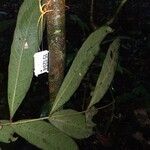Slender tree or treelet, 4-10(13) m tall, unbranched or with few ascending, sympodial branches on distal portion; trunk to 8 cm in diam.; bark grayish to dark brown, smooth or lenticellate. Stem terete, minutely hirsute, sometimes hollow in the center and inhabited by ants. Leaves paripinnate, spirally arranged on distal portion of stem(s); petiole 12-27 (40) cm long, terete, minutely hirsute, greatly enlarged at base; rachis 22-60 cm long, terete, or slightly angled on distal portion, minutely hirsute; petiolules pulvinate, 4-6 mm long, minutely hirsute, glabrescent; leaflets 10-16 (32), opposite to alternate, chartaceous, oblong, elliptic or lanceolate, (5.5) 9-27(53) × (2)3.5-8.5(12) cm, the adaxial surface with impressed venation, glabrous or the midvein minutely tomentose, the abaxial surface minutely hirsute, with prominent venation, the apex acuminate to caudate, the base inequilateral, obtuse-attenuate or rounded-cuneate, the margins entire, slightly revolute. Thyrses panicle-shaped, 30-60 cm long, distal or axillary on distal part of branches; axes terete or slightly angled, hirsute; bracts and bracteoles lanceolate or subulate, hirsute, 1.3-3.5 mm long; dichasia simple, sessile; pedicels < 1 mm long, articulate at the apex. Calyx light green, urceolate, 2.3-4 mm long, minutely hirsute, sometimes intermingled with glandular hairs, the sepals 1.6-3 mm long, ovate-deltate; petals white, 5.5 mm long, oblong, abaxially glabrous, adaxially papillate, rounded at apex, cuneate or cuneate-attenuate at base; appendage as long as the petal, long-deltate, abaxially papillate, adaxially hirsute on distal half; disc 5-lobed, sparsely hirsute, ca. 0.8 mm tall; stamens 8, the filaments of equal or nearly equal length, glabrous, 2-4 mm long, nearly filiform, the anthers oblong or linear-lanceolate, 1.5-1.8 mm long, apiculate at apex; ovary conical, sericeous-hirsute, the stigma elongate-trigonous, ferruginous-papillate. Fruit yellow to orange-yellow at maturity, ovoid to globose, 2-2.5 cm long, densely to sparsely hirsutulose, the pericarp woody, smooth, to 2.5 mm thick. Seed ellipsoid, the testa woody, with a thin, fleshy, yellowish to orange-yellow upper layer, rugulate when dried.
More
A small tree. It grows 4-10 m tall. It has few branches. The trunk is 8 cm across. The stems can be hollow in the centre. The leaves have leaflets arranged in spirals. The leaf stalk is 12-27 cm long. There are 10-16 leaflets. These are 9-27 cm long by 4-8 cm wide. The fruit is yellow or orange when ripe. They are oval and 2-2.5 cm long. The seeds have a thin fleshy layer.


